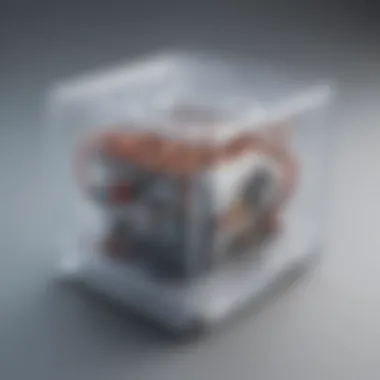Understanding Thermoelectric Cool Boxes and Their Uses


Research Context
Background and Rationale
Thermoelectric cool boxes have emerged as an important technology in the realm of portable cooling solutions. They utilize thermoelectric principles to create a temperature differential, allowing for effective preservation and storage of perishable items. Their significance has grown in various applications, from outdoor activities to medical transport. Understanding the operational mechanics of these devices provides insights into their potential advantages over traditional cooling methods.
Literature Review
Research on thermoelectricity dates back over a century, with a steady increase in interest over the last few decades. Various studies have focused on the materials used in thermoelectric cooling systems, highlighting their efficiency and longevity. Key literature explores the impact of different semiconductor materials on performance. For instance, Bi2Te3 has shown promising thermoelectric properties for cooling applications. Recent advancements in materials science have paved the way for further improvements in efficiency and reduction of environmental impact.
Methodology
Research Design
The investigation into thermoelectric cool boxes involves a mixed-methods approach. This includes both qualitative and quantitative analyses. Qualitative insights come from case studies and user experiences, while quantitative data is derived from performance metrics and energy consumption statistics. This comprehensive design allows for a well-rounded understanding of both user satisfaction and technological efficiency.
Data Collection Methods
Data collection encompasses various methods designed to capture a broad spectrum of information. Surveys targeting users of thermoelectric cool boxes provide firsthand insights into performance and effectiveness. Technical specifications and performance benchmarks from manufacturers serve to inform the efficiency analysis. Structured interviews with experts in thermoelectric technology add depth to the understanding of current trends and future developments in the field.
"The evolution of thermoelectric materials is crucial for the advancement of cooling technologies, especially in applications requiring energy efficiency and portability."
Overall, by contextualizing thermoelectric cool boxes within current technological trends and user experiences, this exploration aims to paint a comprehensive picture of the operational principles, design considerations, and future implications for this innovative technology.
Preface to Thermoelectric Cool Boxes
The world of thermoelectric cool boxes represents a significant intersection of technology and sustainability. These devices, which leverage thermoelectric principles for cooling without the use of traditional refrigerants, are growing in relevance as environmental concerns increase. Understanding thermoelectric cool boxes involves more than merely examining their functionality; it requires an appreciation for their design, applications, and the unique benefits they offer compared to conventional cooling solutions.
Defining Thermoelectric Technology
Thermoelectric technology is rooted in the principles of thermoelectricity, which encompasses the direct conversion of temperature differences into electric voltage and vice versa. The main component at play is the thermoelectric module, often made from materials like bismuth telluride, which can create a heat gradient. This gradient not only allows for cooling but also has applications in power generation. In essence, thermoelectric devices utilize the Peltier Effect for cooling and the Seebeck Effect for generating electrical energy from heat differences.
These devices present a variety of advantages, particularly in small-scale and portable applications where conventional refrigeration is impractical. Due to their solid-state nature, they entail less mechanical complexity, enhancing reliability and lifespan. The absence of moving parts reduces noise, making thermoelectric cool boxes suitable for environments where silence is essential. Furthermore, their compact size facilitates integration into diverse settings from automotive refrigeration to medical supplies.
History and Development
The journey of thermoelectric technology dates back to the early 19th century with the work of scientists like Thomas Seebeck and Jean Charles Athanase Peltier. Seebeck's discovery of the thermoelectric effect in 1821 laid the groundwork for what would eventually be applied in cooling systems. Peltier's subsequent findings in 1834, which detailed how an electric current can create a temperature differential, formed the basis for practical applications of thermoelectrics.
Over the years, advancements in materials science, particularly the development of new thermoelectric materials and improved manufacturing techniques, have propelled the expansion of thermoelectric devices. By the late 20th century, these innovations began to see a foothold in commercial products. As environmental regulations tightened and the need for energy-efficient devices rose, thermoelectric cool boxes emerged as a viable alternative to traditional cooling methods, appealing to both consumer electronics and industrial applications.
Today, the landscape for thermoelectric cooling continues to evolve with ongoing research being directed towards enhancing the efficiency and reducing the costs of thermoelectric materials. Additionally, the integration of renewable energy sources into thermoelectric systems is an exciting area of development, pushing these devices towards greater sustainability.
"Thermoelectric cool boxes provide a sustainable solution for portable cooling needs while potentially reducing the reliance on traditional refrigeration methods."
The significant strides in thermoelectric technology indicate a promising future, not only for cool boxes but for the broader application of thermoelectric principles in various fields. As we explore the fundamentals of thermoelectricity and delve deeper into design aspects, applications, and future innovations, understanding thermoelectric cool boxes becomes vital for researchers and industry professionals alike.
Fundamentals of Thermoelectricity
Understanding the fundamentals of thermoelectricity is essential for appreciating how thermoelectric cool boxes operate. Thermoelectricity encompasses the direct conversion between temperature differences and electric voltage, which is key in many applications beyond cooling. This section will examine the foundational concepts, including the Seebeck effect, the Peltier effect, and thermoelectric modules. Each of these elements plays a crucial role in how thermoelectric technology functions and is applied in various devices.
The Seebeck Effect
The Seebeck effect refers to the generation of an electric voltage when there is a temperature difference across two different conductors or semiconductors. When one junction is heated and the other is kept cool, charge carriers (electrons or holes) migrate from the hot side to the cold side, creating a voltage difference. This principle is most notably applied in thermocouples, which can measure temperature differences with high accuracy.
The Seebeck effect is critical in thermoelectric generators, where heat from various sources can be converted into electrical energy.
Key aspects to consider regarding the Seebeck effect include:


- Materials: The efficiency of the Seebeck effect largely depends on the material used.
- Temperature Gradient: A significant temperature gradient increases the output voltage.
- Thermoelectric Potential: The ratio of voltage produced to the temperature difference can vary based on specific materials.
The Peltier Effect
The Peltier effect is phenomenologically the inverse of the Seebeck effect. It generates cooling or heating at the junction of two different materials when an electric current passes through. When the current flows in one direction, heat is absorbed at one junction and expelled at another. This principle underpins the operation of thermoelectric cool boxes, efficiently transferring heat through solid-state devices without moving parts.
Benefits of the Peltier effect include:
- Compact Design: It allows for smaller cooling solutions without bulky compressors.
- Silent Operation: Unlike traditional cooling mechanisms, Peltier devices operate silently, appealing for various applications.
- Controlled Temperature: These systems can maintain specific thermal environments with precision.
Thermoelectric Modules
Thermoelectric modules consist of multiple thermoelectric elements connected to form a single unit. These modules exploit both the Seebeck and Peltier effects to deliver efficient cooling or heating. A typical module incorporates n-type and p-type semiconductors arranged in a series to optimize performance.
Several advantages of thermoelectric modules include:
- Reliability: With no moving parts, there is less wear and tear, leading to longer lifespan.
- Versatility: They can be applied in various fields such as medical equipment, refrigeration, and automotive solutions.
- Efficiency: Certain designs can operate with minimal power consumption while offering effective heat transfer.
Design Aspects of Thermoelectric Cool Boxes
The design of thermoelectric cool boxes is critical to their effectiveness and efficiency. Various elements come into play when developing these devices. Ensuring optimal performance requires harmonizing multiple components, which can determine both cooling efficiency and user satisfaction. Factors such as material selection, thermal management systems, and power supply considerations are paramount in the overall design.
Material Selection
Choosing the right materials for thermoelectric cool boxes is a key step. The materials must conduct heat effectively while maintaining a balance with thermoelectric performance. Common choices include bismuth telluride and lead telluride, which are known for their thermoelectric properties.
The selection should also focus on durability and weight. Lightweight materials such as aluminum or certain polymer composites can improve portability, making the cool boxes easier to transport. Another point is the insulation used within the cool box. Materials like expanded polystyrene can significantly reduce heat transfer, ensuring the cooling mechanism works more efficiently.
"Material selection profoundly influences the performance and energy footprint of thermoelectric cool boxes."
Factors that need to be considered include:
- Thermal conductivity: Essential for efficient heat transfer.
- Mechanical strength: To withstand environmental stressors and ensure longevity.
- Cost-effectiveness: Must align with the budgetary constraints of production.
Thermal Management Systems
Thermal management is vital in the design of thermoelectric cool boxes. An effective thermal management system enhances the cooling capacity and regulates internal temperature. This includes optimizing airflow and utilizing heat sinks to dissipate heat effectively.
One approach involves using phase change materials (PCMs) which absorb and release heat. PCMs can help maintain stable temperatures inside the cool box, especially in fluctuating ambient conditions. Additionally, integrating fans can improve air circulation, further enhancing cooling performance.
To ensure efficient thermal management, design considerations should include:
- Positioning of components: Arranging parts for optimal airflow and heat dissipation.
- Size of heat sinks: Larger heat sinks often provide better performance.
- Active vs. Passive cooling: Deciding between energy-consuming active systems or more sustainable passive designs.
Power Supply Considerations
The power supply is another crucial design component for thermoelectric cool boxes. Essentially, it needs to be reliable and efficient. Most units use either AC mains or DC input. Portability often calls for battery integration, which introduces additional design challenges.
Battery capacity must match the expected cooling time and performance needs. Lithium-ion batteries are common because of their energy density and longevity. However, their cost and environmental impact should always be evaluated.
Design considerations concerning power supply include:
- Input voltage compatibility: Ensuring the unit can function in various environments.
- Battery management systems: These systems monitor and control the state of the battery, optimizing usage and safety.
- Energy consumption: Efficient designs minimize energy draw, aligning the product with environmental and economic concerns.
In summary, the design aspects of thermoelectric cool boxes are foundational elements that influence their operational effectiveness. Each component from material selection to power supply must be thoughtfully aligned to create a device that is not only effective but also user-friendly and sustainable.
Applications of Thermoelectric Cool Boxes
The applications of thermoelectric cool boxes are vast and varied. Understanding where and how these devices are used helps to illustrate their significance in today's technology landscape. These cool boxes offer unique benefits for a range of industries due to their compact size, low noise operation, and the lack of moving parts. This section explores key areas where thermoelectric cool boxes are applied, showcasing their importance and relevance.


Consumer Electronics
In the realm of consumer electronics, thermoelectric cool boxes provide portable refrigeration solutions. Devices like the Igloo Iceless cooler leverage thermoelectric technology to keep food and drinks cool without the noise of traditional compressors. This is especially beneficial for camping and road trips, where silence and space-saving functionality are necessary. Consumers favor these coolers because they are lightweight and easy to use; you just plug them in and go.
Medical Equipment
Thermoelectric cool boxes also play a crucial role in the medical field. Medical specimens require strict temperature controls to maintain their integrity. Devices like portable vaccine refrigerators utilize thermoelectric cooling to prevent spoilage during transportation. The ability to regulate temperature accurately is vital in safeguarding public health. Efficient, safe, and reliable cooling solutions are essential in maintaining the efficacy of vaccines, blood samples, and other temperature-sensitive products.
Automotive Applications
In automobiles, thermoelectric cool boxes provide innovative solutions for on-the-go refrigeration. For instance, major auto manufacturers have integrated thermoelectric cooling systems into their vehicles to provide passengers with chilled drinks without relying on the car's main cooling system. The compact size allows for space-efficient designs that do not detract from vehicle aesthetics. This combination of convenience and effectiveness enhances the overall driving experience, making it a valuable addition to modern vehicles.
Outdoor and Recreational Uses
The outdoors presents unique challenges where thermoelectric cool boxes shine. Many outdoor enthusiasts utilize these coolers for fishing trips, beach outings, and hiking excursions. They can run off car batteries or portable power banks, making them versatile in off-grid situations. Their reliability in maintaining cooler temperatures for extended periods directly impacts the ability to preserve food and beverages, making them a favorable choice among campers and explorers.
In summary, thermoelectric cool boxes find applications across various industries, significantly impacting consumer electronics, medical equipment, automotive sectors, and outdoor recreation. Their ability to provide efficient cooling solutions reinforces their relevancy and importance in today's marketplace.
Advantages and Disadvantages
Understanding the advantages and disadvantages of thermoelectric cool boxes is essential for anyone interested in their application and operation. This section outlines both the positive aspects and the challenges associated with these cooling devices.
Efficient Cooling Mechanism
The primary advantage of thermoelectric cool boxes is their efficient cooling mechanism. These devices utilize the Peltier effect, which allows for direct heat transfer from one side of a thermoelectric module to the other. By doing so, they can cool down a space without needing moving parts as found in traditional cooling systems.
- Compact Design: Due to their lack of mechanical parts, thermoelectric cool boxes can be designed in a more compact and lighter manner, allowing for easier transport and integration into various environments.
- No Refrigerant: Unlike conventional refrigeration systems, thermoelectric coolers do not require any refrigerant, which means they are easier to maintain and less impactful on the ozone layer.
Overall, the efficient design of these coolers makes them suitable for a variety of applications, from home use to specialized medical equipment.
Environmental Impact
There is a growing emphasis on sustainable technologies, and thermoelectric cool boxes play a role in this discussion. Their environmental impact can be assessed in several ways:
- Absence of Harmful Gases: As stated earlier, these devices do not rely on refrigerants that can contribute to global warming or ozone depletion. This is a significant advantage as nations strive for greener alternatives.
- Low Energy Consumption: Thermoelectric cooling often consumes less energy compared to traditional systems, especially in small-scale applications. This can lead to reduced electricity bills and a lower carbon footprint.
Despite these advantages, it is crucial to recognize that the materials used in manufacturing thermoelectric devices may sometimes pose environmental challenges during sourcing and disposal. Thus, while the operational impact tends to be positive, a complete environmental assessment should consider the life cycle of the materials involved.
Limitations of Thermoelectric Cooling
No technology is without its drawbacks, and thermoelectric cool boxes are no exception. The limitations can influence their efficiency and effectiveness:
- Heat Dissipation: Thermoelectric devices often struggle with heat dissipation, which can limit their cooling power. Consequently, these coolers are less effective for large volumes of space compared to traditional refrigeration systems.
- Cost Effectiveness: While they offer advantages, the initial cost of thermoelectric modules can be higher than those of conventional cooling methods. This can be a barrier for consumers when considering the kind of cooling solution they need.
- Temperature Limitations: These devices generally work best within a limited temperature range. Exceeding these limits can result in decreased performance or even system failure.
Comparative Analysis with Traditional Cooling Methods
The comparative analysis of thermoelectric cool boxes with traditional cooling methods is crucial in understanding their positioning within the cooling technology landscape. Thermoelectric cooling, despite its unique principles and applications, encounters both advantages and limitations when pitted against established methods such as mechanical refrigeration. This analysis enables potential users to make informed choices based on their specific cooling needs, whether in domestic or industrial settings.
Mechanical Refrigeration vs. Thermoelectric Cooling
Mechanical refrigeration has been the standard method for cooling in numerous applications, primarily because it provides a high level of cooling efficiency over larger temperature differentials. It employs a vapor-compression cycle, which uses refrigerants to absorb and dissipate heat. The system includes complex components like compressors and condensers. In contrast, thermoelectric cooling operates on the Peltier effect, which creates a temperature differential when electrical current passes through two different conductors. This inherently simpler design leads to several notable differences:
- Size and Portability: Thermoelectric coolers are generally more compact and lighter than traditional units, making them suitable for portable applications such as picnic cooling and mobile refrigeration.
- Environmental Considerations: Unlike mechanical refrigeration, thermoelectric devices do not rely on harmful refrigerants. This reduces their environmental impact, aligning with growing concerns over climate change.
- Energy Efficiency: While thermoelectric systems may not achieve the same efficiency levels under heavy loads, their efficiency at lower cooling applications can be notable, particularly when powered by renewable energy sources.
- Noise Levels: Thermoelectric cool boxes operate silently, which can be a significant advantage in settings where noise pollution is a concern.
Cost Efficiency Considerations
When evaluating cost efficiency, both initial investment and operational expenses must be taken into account. Mechanical refrigeration systems tend to have lower upfront costs when considering high-capacity needs. However, their operational costs can be higher due to extensive energy requirements and maintenance.
Thermoelectric coolers usually require less maintenance as they have fewer moving parts. Their operational efficiency can improve significantly when powered by renewable energy sources, potentially leading to reduced energy costs over time. Despite their efficiency in small-scale cooling tasks, the initial purchase price of advanced thermoelectric systems might be higher, which can deter some users.


Recent Innovations in Thermoelectric Technology
Recent developments in thermoelectric technology are transforming how we view cooling solutions. These innovations not only enhance efficiency but also open new avenues for applications. Advancements in materials and integration with renewable energy sources improve the performance of thermoelectric cool boxes. These factors make the technology more sustainable while reducing reliance on traditional, more energy-intensive methods.
Advanced Materials Development
The race for better thermoelectric materials is ongoing. Traditionally, materials like bismuth telluride are used for thermoelectric applications. However, recent innovations include the exploration of new compounds and alloys. Researchers are investigating materials such as strontium titanate and various nanostructured semiconductors.
Benefits of these new materials include:
- Higher efficiency: New materials can have better thermoelectric performance. This leads to more effective cooling with less power consumption.
- Reduced weight: Lighter materials allow for more portable designs of cool boxes, ideal for outdoor or recreational uses.
- Enhanced durability: Some advanced materials offer greater resistance to temperature fluctuations and environmental factors, extending the lifespan of the devices.
The development of these materials requires significant research investments. However, the benefits justify the costs as industries see the potential for long-term savings and performance gains.
Integration with Renewable Energy Sources
As the world shifts towards sustainable practices, integrating thermoelectric cool boxes with renewable energy sources becomes increasingly relevant. Solar panels, for instance, can power these cool boxes in remote locations. Integrating solar energy reduces dependence on grid power, enhancing portability and efficiency.
Considerations include:
- Energy independence: Using renewable resources means less reliance on fossil fuels. This can appeal to eco-conscious consumers.
- Cost effectiveness: While the initial setup may be high, long-term operational costs can decrease significantly with renewable energy integration.
- Environmental impact: Using clean energy for cooling reduces carbon footprints, aligning with global sustainability goals.
"Innovations in thermoelectric technology are not just about efficiency; they are about envisioning an eco-friendly future."
Overall, recent innovations in thermoelectric technology underscore its potential to revolutionize how we cool our goods and maintain temperatures. The ongoing research aims to expand these applications further, paving the way for a more sustainable tomorrow.
Future Trends in Thermoelectric Cooling
The ongoing advancements in thermoelectric cooling technology are paving the way for a multitude of future trends. As industries seek more energy-efficient and environmentally friendly cooling solutions, thermoelectric cool boxes stand out for their unique operational characteristics. This section explores emerging market opportunities within this arena and the associated technological advancements and challenges that shape the future of this technology.
Emerging Market Opportunities
Demand for thermoelectric cool boxes is expanding in various sectors, including:
- Consumer Electronics: With the rise of portable devices and gaming consoles, there is a growing need for effective cooling solutions. Manufacturers are exploring thermoelectric technology to enhance battery life and overall product performance.
- Medical Sector: Medications and vaccines often require strict temperature control. Thermoelectric cool boxes can ensure stable temperatures during transport, addressing challenges posed by traditional cooling methods.
- Green Technology: Eco-conscious consumers are driving the demand for sustainable solutions. Thermoelectric units, with their low carbon footprint, appeal to this demographic.
- Automotive Industry: As electric vehicles gain traction, manufacturers seek advanced cooling strategies to maintain battery efficiency. Thermoelectric cooling can play a pivotal role in this segment.
The opportunities are not just confined to these sectors. Innovations in design and materials can lead to the creation of niche markets in industrial applications, food transportation, and outdoor recreational equipment. The ability to harness renewable energy sources further widens the horizon for thermoelectric cool boxes in emerging markets.
Technological Advancements and Challenges
While the prospects are promising, several technological advancements and challenges impact the future of thermoelectric cooling. Key points include:
- Material Innovation: Research into new thermoelectric materials such as bismuth telluride and skutterudites is ongoing. These materials promise higher efficiencies and lower costs.
- Integration with Smart Technologies: The push towards smart homes and IoT devices is likely to influence thermoelectric cooling systems. The incorporation of sensors and smart controls can enhance efficiency.
- Cost Concerns: While material advancements aim to reduce costs, the current expense surrounding thermoelectric components remains a barrier. Ongoing research must address economic viability.
- Performance Temperature Range: The efficiency of thermoelectric coolers diminishes at extreme temperatures. Developing technologies that operate effectively across a broader temperature spectrum is crucial.
"Understanding market needs and addressing technical limitations will be essential for advancing thermoelectric cooling technology into mainstream applications."
Culmination
The conclusion of this article serves as an important summary and reflection on the themes explored throughout the various sections on thermoelectric cool boxes. Understanding how thermoelectric technology operates and its relevance to modern cooling solutions is crucial in numerous fields, including consumer electronics, medical equipment, and automotive applications.
Summary of Key Points
In this article, several key points were highlighted:
- Thermoelectric Principles: The operational principles, based on the Peltier and Seebeck effects, show how temperature differentials can be effectively harnessed for cooling.
- Design Considerations: Material choices influence the efficiency and effectiveness of thermoelectric cool boxes, emphasizing the importance of thermal management systems.
- Applications: The versatility of thermoelectric cool boxes across various industries demonstrates their potential to revolutionize conventional cooling methods. They are notable in medical environments where maintaining specific temperature ranges is critical.
- Advantages: Compared to traditional cooling systems, thermoelectric coolers offer benefits such as reduced environmental impact and higher energy efficiency.
- Innovations and Future Trends: Advancements in materials and integration with renewable energy are paving the way for wider adoption in the future.
Encouragement for Further Research
Continued research in the field of thermoelectric technology is essential. The current state of thermoelectric cool boxes presents opportunities for improvements in efficiency and cost-effectiveness. Exploring novel materials and their applications can lead to better performance metrics. Furthermore, interdisciplinary studies that integrate thermoelectric cooling with renewable energy sources can enhance sustainability.
By investigating these areas and addressing existing limitations, future innovations can significantly expand the practicality and appeal of thermoelectric cool boxes in everyday applications. The dialogue around their potential will only become more relevant as we face global challenges related to climate change and energy efficiency.
"Advancement in thermoelectric materials could lead to transformative changes in how we approach energy consumption and cooling needs across various industries."
In summary, thermoelectric cool boxes not only represent a fascinating scientific principle but also an actionable pathway towards improved technologies and environmental stewardship.



